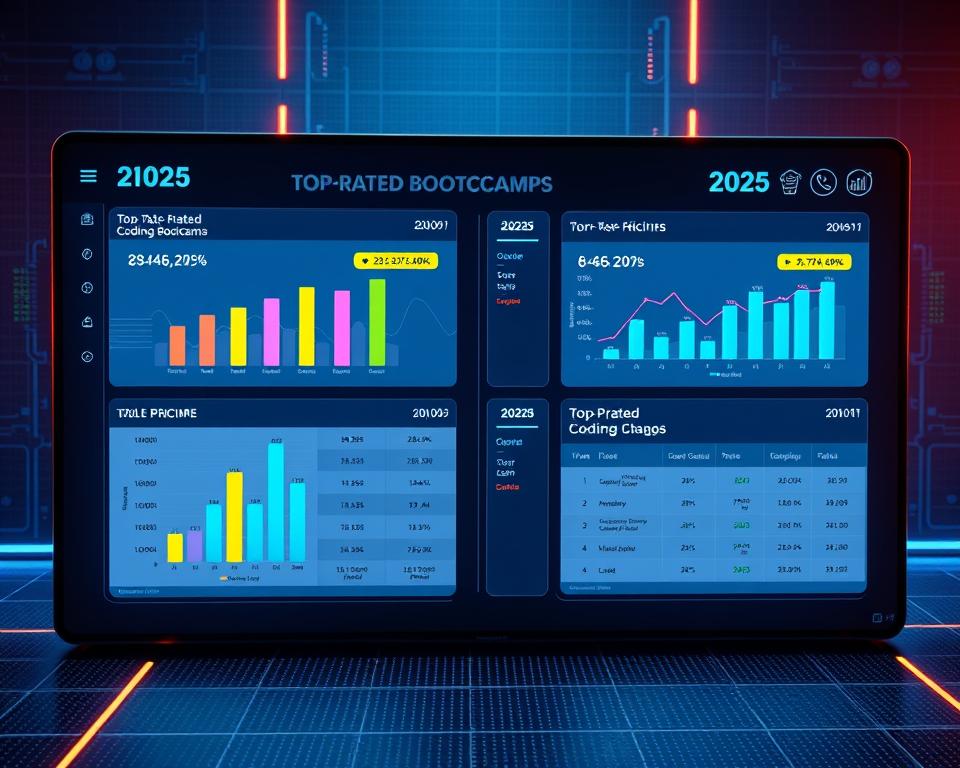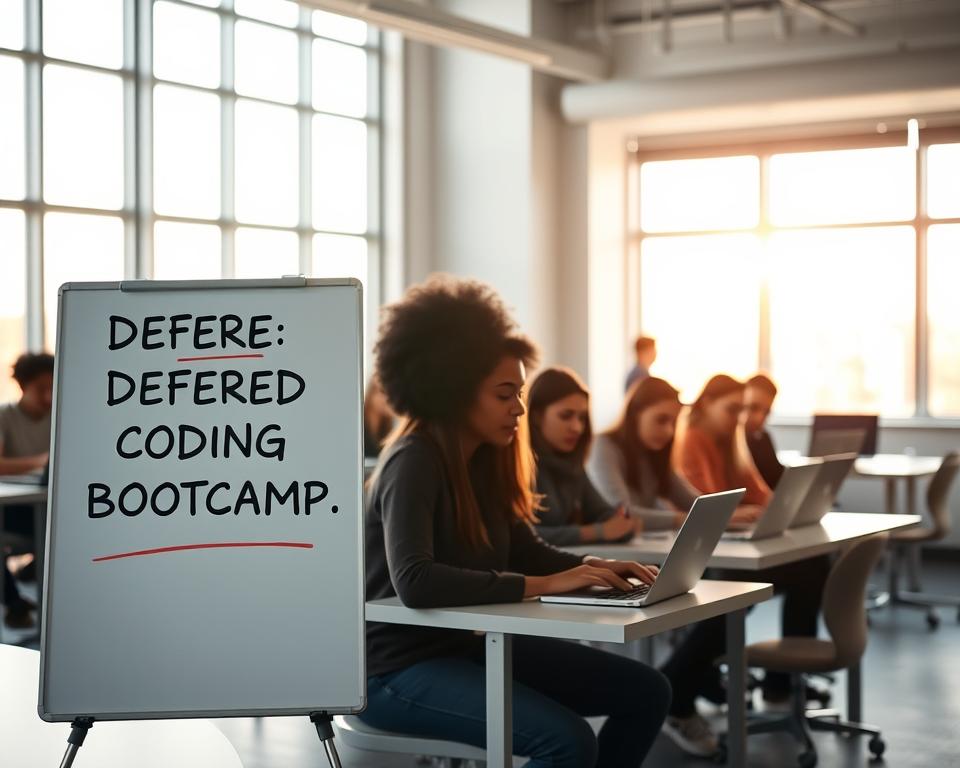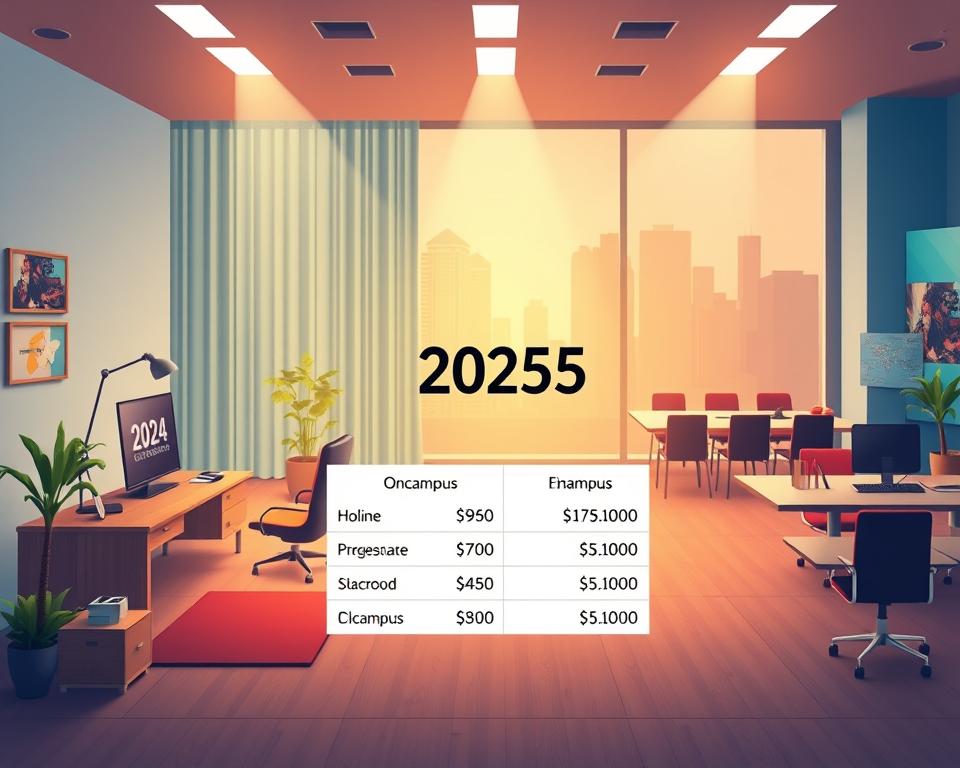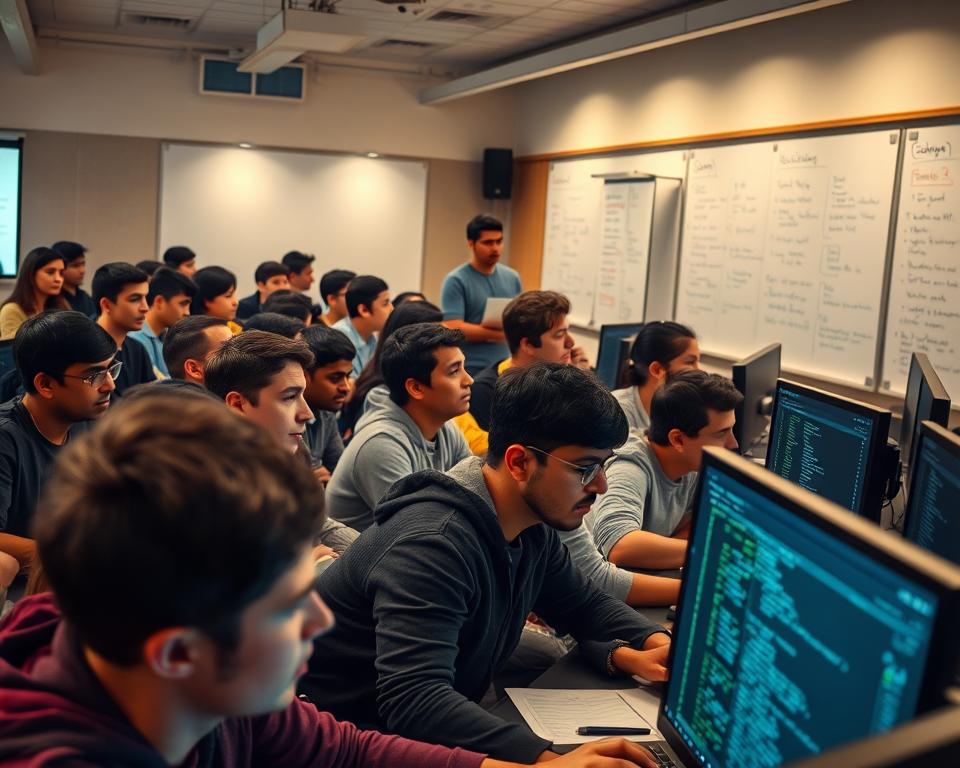
How Much Do Coding Bootcamps Cost? 2025 Price Comparison
By 2025, over 100,000 Americans will enroll in tech training programs to pivot careers, yet nearly 60% underestimate the financial commitment required. As demand for digital skills surges, understanding the true cost of immersive tech education becomes critical for aspiring developers and career changers.
This guide breaks down current pricing trends across full-time, part-time, and deferred-tuition programs. With tuition ranging from $7,000 to $21,000 nationally, choosing the right investment requires analyzing multiple factors beyond sticker prices. Payment plans, income share agreements, and scholarships now reshape accessibility in tech education.
Real-world examples from leading providers reveal how program length, specialization tracks, and career support influence value. Whether transitioning from hospitality or finance, strategic budgeting helps learners maximize returns in competitive tech job markets.
Key Takeaways
- Tuition costs vary significantly based on program format and duration
- Deferred payment options reduce upfront financial barriers
- Immersive courses often provide faster career outcomes
- Market data shows regional price differences up to 40%
- Financing plans now cover living expenses at select schools
- Employer partnerships increasingly subsidize tuition costs
Overview of Coding Bootcamp Costs in 2025
Career transitions into tech now frequently begin with accelerated learning pathways rather than traditional degrees. The average immersive program costs $13,584 nationally, with prices spanning $7,800 to $21,000 depending on structure and location. This investment typically includes 12-28 weeks of hands-on training in modern technologies like JavaScript frameworks and cloud development tools.
Understanding the Investment Required
Full-time programs demand the highest financial commitment but deliver faster outcomes, often requiring 40+ weekly hours. Part-time options spread costs over 6-9 months while allowing continued employment. Key factors influencing price:
| Program Type | Average Duration | Tuition Range | Core Technologies |
|---|---|---|---|
| Full-Time | 12-16 weeks | $15,000-$21,000 | React, Node.js, Python |
| Part-Time | 24-28 weeks | $9,500-$14,000 | HTML/CSS, JavaScript |
| Extended | 32+ weeks | $7,800-$12,000 | Front-end fundamentals |
Market Trends and Data Insights
Tuition costs rose 8% since 2023 as programs expanded career services and AI-driven curriculum updates. Regional differences remain significant – West Coast prices average 18% higher than Southern states. Over 75% of institutions now offer income share agreements, reducing upfront payments for qualified applicants.
Employer partnerships increasingly shape program content and pricing. Tech companies now subsidize 22% of seats at partner schools in exchange for hiring priority. This trend makes strategic program selection crucial for maximizing return on investment.
Exploring Tuition Ranges: $5,000 – $10,000 to $20,000+
Accelerated tech training programs now cater to diverse budgets, with entry fees spanning three distinct tiers. While shorter courses focus on foundational skills, comprehensive curricula and career services drive premium pricing. Let’s examine what different price brackets deliver.
Low-Cost Options and Budget-Friendly Programs
Entry-level courses like Coding Nomads’ $6,950 full-stack track prioritize core programming fundamentals. These programs typically run 12-16 weeks and focus on:
- Essential web development languages (HTML, CSS, JavaScript)
- Project-based learning with peer collaboration
- Basic job search guidance
Premium Bootcamps and Additional Services
Flagship institutions charge $16,000-$21,000 for intensive programs featuring:
- 1:1 career coaching and interview simulations
- Specialized tracks in AI integration or cloud development
- Lifetime access to updated course materials
| Price Tier | Program Length | Key Features | Example Provider |
|---|---|---|---|
| $5k-$10k | 12-18 weeks | Core coding skills, group projects | Coding Nomads |
| $11k-$15k | 20-28 weeks | Mentorship, portfolio reviews | Tech Elevator |
| $16k+ | 12-16 weeks | Career guarantees, specialization | Flatiron School |
Extended support systems in premium programs often lead to 34% faster job placement according to recent graduate surveys. Learners should match program intensity with their career timelines and learning preferences.
Deferred/Contingent and Free/Zero Tuition Bootcamps
Alternative payment structures are revolutionizing access to technical education. Over 40% of tech training providers now offer deferred tuition or income-based repayment plans. These models let students focus on skill-building first while addressing financial barriers.

Deferred Tuition Models Explained
Deferred plans delay payments until graduates secure tech jobs. Students typically repay tuition through fixed monthly installments or a percentage of their income. “Our goal is to align success with accessibility,” notes a director at Code Forward Academy.
| Payment Model | Upfront Cost | Repayment Terms | Example |
|---|---|---|---|
| Upfront Payment | $15,000 | None | Standard Option |
| Deferred Tuition | $0 | 10% salary for 2 years | TechBridge Institute |
| Income Share | $0 | 15% income for 3 years | App Academy |
| Free Program | $0 | Employment commitment | Ada Developers Academy |
Benefits of Free and Zero Tuition Programs
Select schools remove tuition entirely for qualified applicants. App Academy’s income share agreement requires no upfront payments – graduates pay 15% of earnings for three years after landing $50k+ roles. Nonprofits like Code Liberation focus on underrepresented groups, offering free education in exchange for mentorship commitments.
While these options increase accessibility, students should review contract terms carefully. Deferred plans might cost more long-term but enable immediate career transitions. As tech education evolves, flexible payment structures continue bridging opportunity gaps.
How Much Do Coding Bootcamps Cost? 2025 Price Comparison
Tech career seekers face diverse pricing models when evaluating intensive training options. Four primary tuition brackets now dominate the market, each offering distinct advantages based on career goals and financial capacity.

Exact Cost Breakdown by Range
Entry-level programs ($5,000-$10,000) like Codecademy’s career path focus on foundational skills across 12-18 weeks. Mid-tier options ($10,001-$15,000) often include portfolio reviews and basic career coaching. General Assembly’s flagship course sits in the $15,001-$20,000 bracket, delivering specialized tracks and 1:1 mentorship.
Premium programs exceeding $20,000 typically offer job guarantees and lifetime curriculum access. “Our income share option lets students pay 10% of earnings for two years after securing $50k+ roles,” explains a General Assembly admissions advisor. This model eliminates upfront payments while aligning program success with graduate outcomes.
Key Considerations When Comparing Bootcamp Prices
Program length directly impacts both time commitment and cost structure. Twelve-week intensives demand full focus but accelerate job readiness, while six-month part-time courses allow continued employment. Recent data shows graduates from programs over $15,000 secure tech positions 28% faster than budget alternatives.
When evaluating prices, prioritize schools with transparent outcome reports and flexible financing. Income share agreements reduce initial barriers but require careful evaluation of long-term implications. The best investments balance comprehensive training with career support tailored to individual timelines and learning styles.
Comparing On-Campus vs. Online Coding Bootcamp Costs
The evolution of technical education offers learners two primary pathways: traditional classroom settings and digital platforms. Recent data shows online programs average $11,118 over 15 weeks, while in-person options cost slightly more at $11,906 for 14 weeks. This price difference reflects varying operational expenses and learning structures.

Differences in Tuition and Duration
While tuition gaps appear minimal, online courses often reduce ancillary expenses like commuting or relocation. Both formats deliver identical core web development curricula through different teaching methods:
| Feature | Online | On-Campus |
|---|---|---|
| Average Tuition | $11,118 | $11,906 |
| Duration | 15 weeks | 14 weeks |
| Scheduling | Flexible | Fixed |
| Key Advantage | Self-paced learning | Immediate feedback |
Remote learning options provide 24/7 access to materials and recorded lectures, ideal for working professionals. However, self-directed schedules demand strong time management skills. Campus-based programs foster real-time collaboration but require physical attendance.
Graduates from both formats report comparable starting salaries, though in-person learners often benefit from stronger local industry connections. A 2024 CareerKarma survey found 78% of campus attendees secured roles within three months versus 72% for remote peers.
Leading schools now tailor experiences to each format – online cohorts use virtual labs for cloud computing projects, while campus programs host onsite hackathons with tech recruiters. These adaptations ensure all students gain relevant skills for modern web development careers.
Financing Options for Coding Bootcamps
Navigating education financing requires understanding modern solutions that align with career goals. Tech training providers now offer multiple pathways to manage costs while building in-demand skills. Let’s explore strategies that make immersive programs accessible across financial situations.

Scholarships, Income Share Agreements, and Loans
Leading institutions provide tailored financial support to reduce upfront barriers. General Assembly offers $3 million annually in scholarships for women and underrepresented groups. Income share agreements (ISAs) let students repay 10-15% of their salary after securing tech roles.
Key options include:
- Upfront payments (5-10% discounts at select schools)
- Deferred plans with $0 tuition until employment
- Third-party loans through partners like Climb Credit
Payment Plans and Installment Options
Many programs split tuition into monthly payments without interest. Flatiron School’s 24-month plan allows $500/month installments while studying. Compare structures:
| Method | Upfront Cost | Savings | Flexibility |
|---|---|---|---|
| Full Payment | $15,000 | $1,500 discount | Low |
| Installments | $0 | None | High |
| ISA | $0 | Varies | Income-based |
App Academy’s “Pay Nothing Until You’re Hired” model demonstrates how payment plans adapt to graduate success. Always review contract terms – some ISAs cap total repayment amounts based on earnings.
Bootcamp Provider Comparisons and Reviews
Leading tech educators now face intense scrutiny as career changers demand proven results. Course Report data reveals three institutions consistently rank highest for job-ready training: General Assembly, Flatiron School, and Hack Reactor. Each combines rigorous curricula with distinct approaches to software engineering and web development education.

Featured Providers: General Assembly, Flatiron School, and Hack Reactor
General Assembly’s 12-week immersive program emphasizes real-world projects, with 91% of 2024 graduates securing tech roles averaging $78,000 salaries. Flatiron School counters with structured, self-paced courses featuring 1:1 mentorship – ideal for career switchers needing flexibility. Hack Reactor’s software engineering focus delivers 300+ hours of JavaScript practice, though its $17,980 tuition sits at the premium end.
| Provider | Cost | Duration | Key Strength |
|---|---|---|---|
| General Assembly | $15,950 | 12 weeks | Industry partnerships |
| Flatiron School | $16,900 | 15 weeks | Personalized coaching |
| Hack Reactor | $17,980 | 13 weeks | Technical depth |
Student Reviews and Outcome Data
Recent alumni praise Hack Reactor’s career support team for helping negotiate 22% higher starting salaries on average. One graduate shared: “The program’s intensity mirrored actual tech workflows, making my transition seamless.” Flatiron students highlight accessible instructors, while 84% of General Assembly graduates credit networking events for job opportunities.
Outcome reports show stark contrasts in specialization:
- Web development focus: 89% placement rate at mid-tier programs
- Software engineering tracks: 94% placement in higher-paying roles
When evaluating bootcamp costs, consider hidden value factors like alumni networks and continuing education. As coding education evolves, informed decisions require balancing price with proven graduate success metrics.
Payment Methods: Upfront Payment, Installments, and Deferred Options
Tech education providers now offer multiple pathways to manage program fees while balancing financial constraints. Three primary payment structures dominate the market: immediate lump sums, staggered installments, and post-graduation repayment models. Each approach caters to different financial situations and career goals.

Benefits of Paying Upfront
Full tuition payments often unlock discounts at many bootcamps. General Assembly provides 8% savings for students who pay $15,950 immediately. Upfront payments eliminate long-term financial obligations, allowing learners to focus entirely on skill development.
Key advantages include:
- Reduced total bootcamp cost through early payment incentives
- Simplified budgeting with no future repayment calculations
- Priority access to premium career services at select schools
When to Consider Installment or Deferred Plans
Deferred options prove valuable for career changers needing immediate training. App Academy’s income share agreement requires $0 upfront, with graduates paying 15% of earnings for three years after securing $50k+ roles. Installment plans spread payments over 6-24 months, ideal for part-time students maintaining employment.
| Method | Upfront Cost | Repayment Terms | Best For |
|---|---|---|---|
| Full Payment | $14,000 | None | Budget-ready learners |
| Installments | $2,500 | 12 months | Working professionals |
| Deferred Plan | $0 | 10% salary x 2 years | Career pivots |
Flatiron School and Tech Elevator now provide clear financing calculators to compare total costs across payment methods. Always review contract terms – some deferred plans cap repayments at 1.5x original tuition.
Factors Influencing Bootcamp Costs Beyond Tuition
Total education expenses in tech training extend far beyond initial tuition fees. A 2024 CareerSwitch study found 42% of students spend 15-30% more than program prices due to overlooked factors. These hidden costs impact budgeting strategies for aspiring developers.

Program Structure and Resource Requirements
Extended programs often include mandatory pre-work – 50+ hours of foundational exercises before classes start. Full-stack tracks with software engineering specializations may charge 18% more for:
- Cloud platform access fees
- Specialized development tools
- Technical mentor sessions
| Program Length | Average Added Costs | Common Resources |
|---|---|---|
| 12 weeks | $480 | Basic IDE access |
| 24 weeks | $1,150 | AI coding assistants |
| 36 weeks | $2,300 | Cloud server credits |
Geographic and Format Variations
Onsite programs in tech hubs cost 22% more than online equivalents, according to SwitchUp data. Hybrid models blend digital flexibility with in-person networking events. Urban locations often provide stronger software industry connections but increase living expenses.
Financial aid opportunities like Women Who Code scholarships reduce net costs by $3,000-$5,000 for qualifying applicants. Always calculate total investment by combining tuition, materials, and location-based expenses.
Tips for Budgeting Your Coding Bootcamp Investment
Smart financial preparation transforms tech education from a burden to a strategic career move. Begin by mapping expenses across the entire learning journey – most programs require budgeting for 6-9 months of focused study and career transition.
Building Your Financial Roadmap
Start with a three-phase approach:
- Pre-program: Save 3 months’ living expenses
- During training: Allocate funds for tools/software
- Post-graduation: Plan for 2-4 months of job search
Financial advisor Maya Cortez advises: “Treat your education like a startup – forecast expenses, revenue timelines, and contingency plans.” Use free budgeting templates from platforms like Mint to track daily costs against savings goals.
| Program Cost | Average Salary | Break-Even Months |
|---|---|---|
| $12,000 | $72,000 | 6 |
| $18,000 | $85,000 | 8 |
Explore scholarships 6 months before enrollment dates. Many providers offer early-bird discounts – CodeSmith’s 10% tuition reduction for applications submitted 90 days pre-start.
Balance payment methods with earning potential. Income share agreements work best for career switchers, while installment plans suit employed learners upskilling part-time. Always compare total repayment amounts across options.
Conclusion
Tech education investments demand strategic evaluation as immersive programs evolve. With average tuition at $13,584 and specialized tracks reaching $21,000, selecting the right path requires balancing career goals with financial realities.
Deferred tuition models and income share agreements now make engineering careers accessible without upfront payments. Premium programs demonstrate value through 34% faster job placement rates and lifetime learning resources.
Key benchmarks remain crucial: part-time options average $11,000, while intensive courses deliver results in 12 weeks. Consider hidden expenses like software licenses and mentorship fees when budgeting.
The long-term payoff becomes clear when aligned with industry demand – engineering roles offer median salaries exceeding $85,000. Review outcome reports, attend trial classes, and connect with alumni before committing.
Smart planning transforms technical training into career acceleration. Use platforms like Course Report and LinkedIn to compare graduate success stories. Your future in tech starts with informed decisions today.
FAQ
What is the average tuition for coding bootcamps in 2025?
How do deferred tuition models work?
Are there free coding bootcamps available?
What financing options exist beyond loans?
Do online programs cost less than on-campus options?
Which providers offer scholarships or income share agreements?
Should I pay upfront or use installment plans?
Are Remote Coding Bootcamps More Affordable Compared to In-Person Options in 2025?
As 2025 evolves, many learners are discovering that remote coding bootcamps with flexible 2025 options often come with lower price tags compared to traditional in-person programs. This affordability, coupled with the convenience of online learning, makes remote bootcamps an attractive choice for aspiring coders looking to minimize debt.
FAQ
What is the average tuition for coding bootcamps in 2025?
Programs typically range from ,000 to ,000+, with budget-friendly options like freeCodeCamp and low-cost courses. Premium bootcamps like Hack Reactor or Flatiron School often charge ,000–,000 for full-stack development or software engineering tracks.
How do deferred tuition models work?
Deferred plans let students pay after securing a job, often with income share agreements (ISAs). For example, App Academy requires 15–20% of post-graduation salary for a set period. Always review repayment terms and income thresholds.
Are there free coding bootcamps available?
Yes. Organizations like freeCodeCamp and 42 offer zero-tuition programs. Some providers, including Per Scholas, combine free tuition with career support. These programs often prioritize underrepresented groups or require upfront admissions challenges.
What financing options exist beyond loans?
Many bootcamps partner with lenders like Climb Credit for low-interest loans. Scholarships, such as General Assembly’s Opportunity Fund, reduce upfront costs. Income share agreements (ISAs) are popular for high-quality programs like BloomTech.
Do online programs cost less than on-campus options?
Online courses often save ,000–,000 by eliminating campus fees. For example, Flatiron School’s online software engineering program costs ,900, while some in-person tracks exceed ,000. Hybrid models may include extra resources.
Which providers offer scholarships or income share agreements?
Hack Reactor provides merit-based scholarships and ISAs with a ,000 minimum salary threshold. General Assembly offers needs-based awards, while Codecademy’s bootcamps feature deferred tuition for career switchers.
Should I pay upfront or use installment plans?
Upfront payments often include discounts (e.g.,
FAQ
What is the average tuition for coding bootcamps in 2025?
Programs typically range from $5,000 to $20,000+, with budget-friendly options like freeCodeCamp and low-cost courses. Premium bootcamps like Hack Reactor or Flatiron School often charge $16,000–$20,000 for full-stack development or software engineering tracks.
How do deferred tuition models work?
Deferred plans let students pay after securing a job, often with income share agreements (ISAs). For example, App Academy requires 15–20% of post-graduation salary for a set period. Always review repayment terms and income thresholds.
Are there free coding bootcamps available?
Yes. Organizations like freeCodeCamp and 42 offer zero-tuition programs. Some providers, including Per Scholas, combine free tuition with career support. These programs often prioritize underrepresented groups or require upfront admissions challenges.
What financing options exist beyond loans?
Many bootcamps partner with lenders like Climb Credit for low-interest loans. Scholarships, such as General Assembly’s Opportunity Fund, reduce upfront costs. Income share agreements (ISAs) are popular for high-quality programs like BloomTech.
Do online programs cost less than on-campus options?
Online courses often save $2,000–$5,000 by eliminating campus fees. For example, Flatiron School’s online software engineering program costs $16,900, while some in-person tracks exceed $20,000. Hybrid models may include extra resources.
Which providers offer scholarships or income share agreements?
Hack Reactor provides merit-based scholarships and ISAs with a $25,000 minimum salary threshold. General Assembly offers needs-based awards, while Codecademy’s bootcamps feature deferred tuition for career switchers.
Should I pay upfront or use installment plans?
Upfront payments often include discounts (e.g., $1,000 off at Fullstack Academy). Installment plans split costs into monthly payments. Deferred options suit those needing flexibility, but compare interest rates or income-sharing terms first.
What factors beyond tuition affect total costs?
Pre-work materials, housing for in-person programs, and extended career support can add expenses. Bootcamps in tech hubs like NYC or SF may cost 10–15% more. Part-time schedules often reduce income loss during training.
What factors beyond tuition affect total costs?
Pre-work materials, housing for in-person programs, and extended career support can add expenses. Bootcamps in tech hubs like NYC or SF may cost 10–15% more. Part-time schedules often reduce income loss during training.